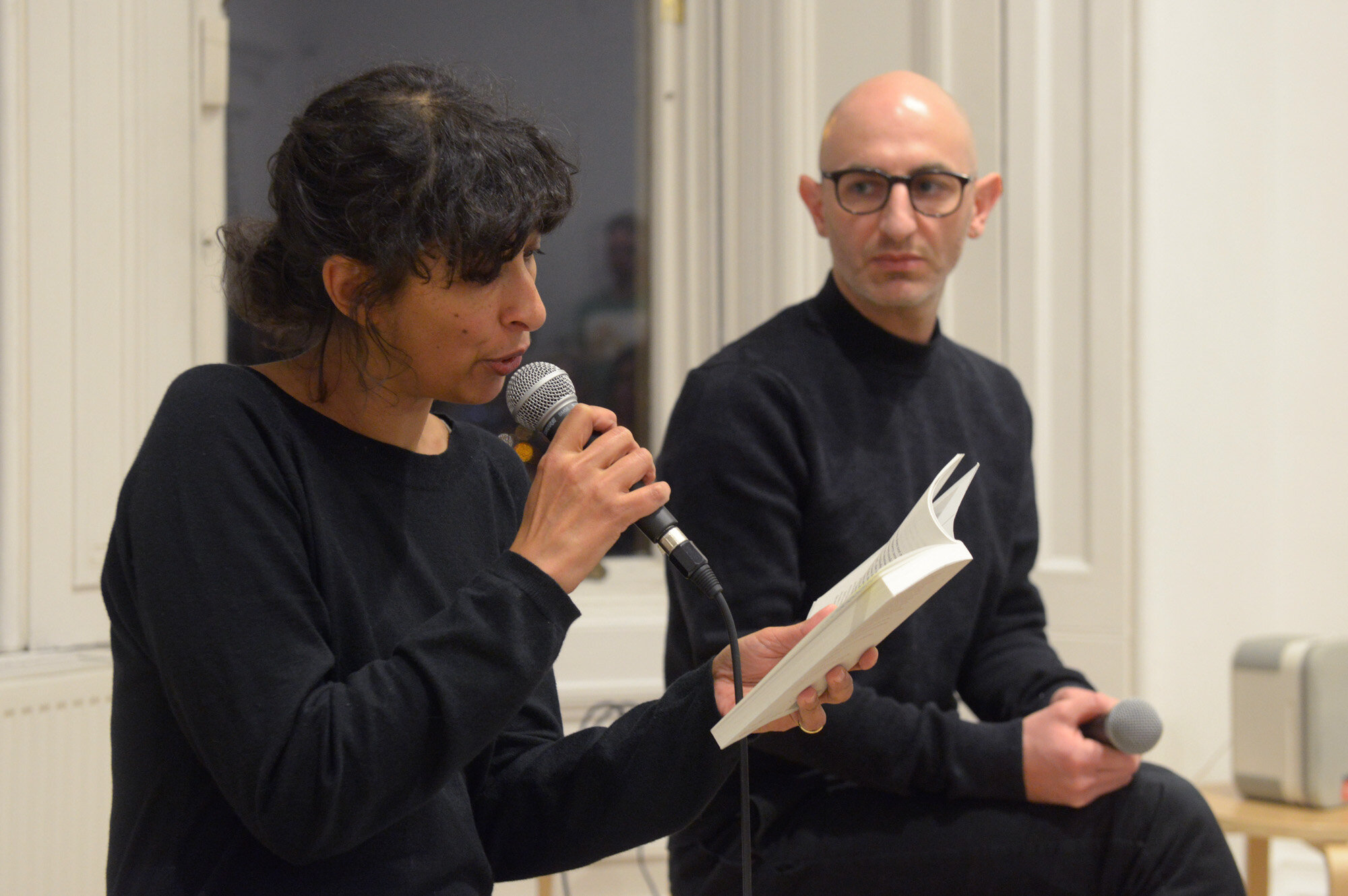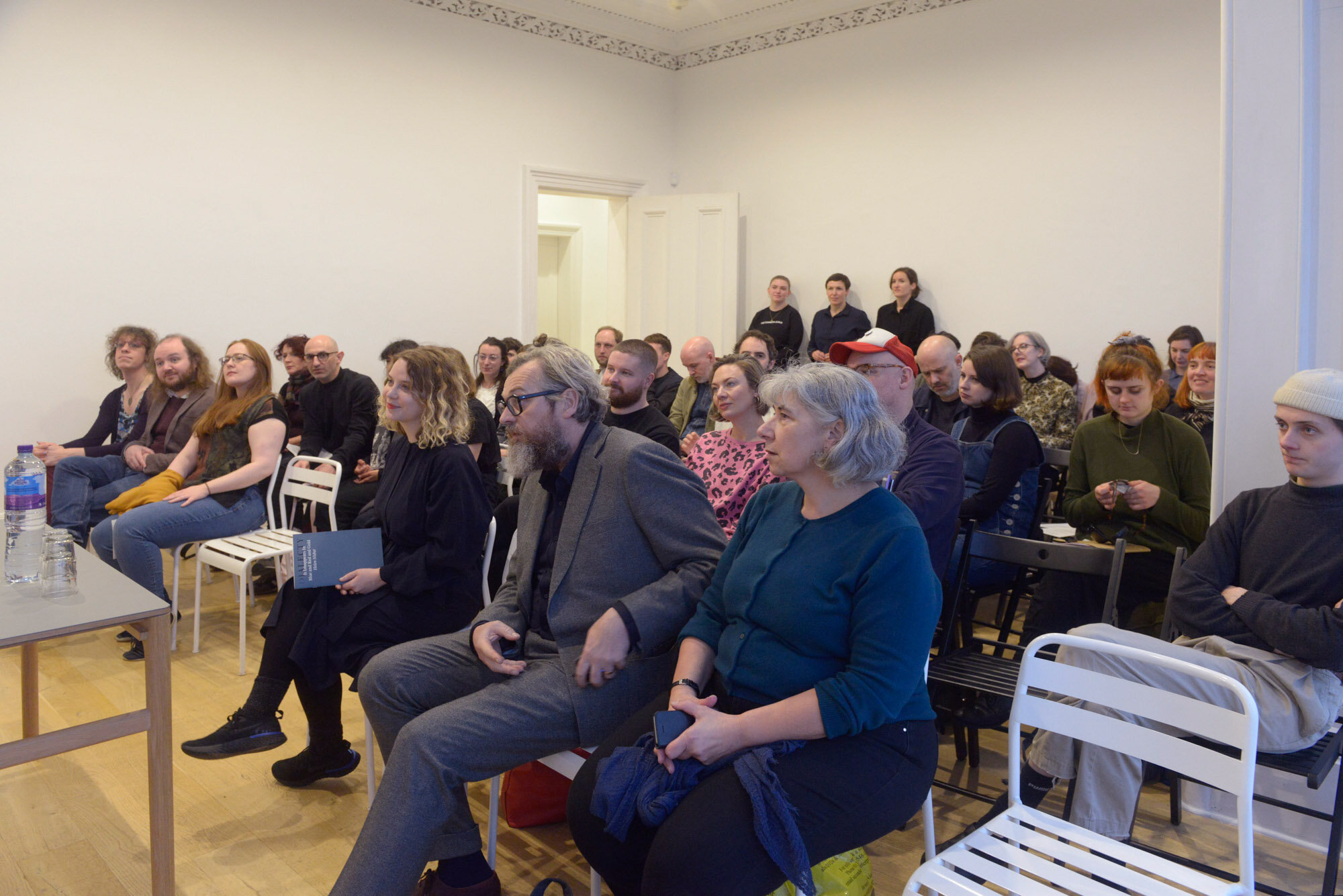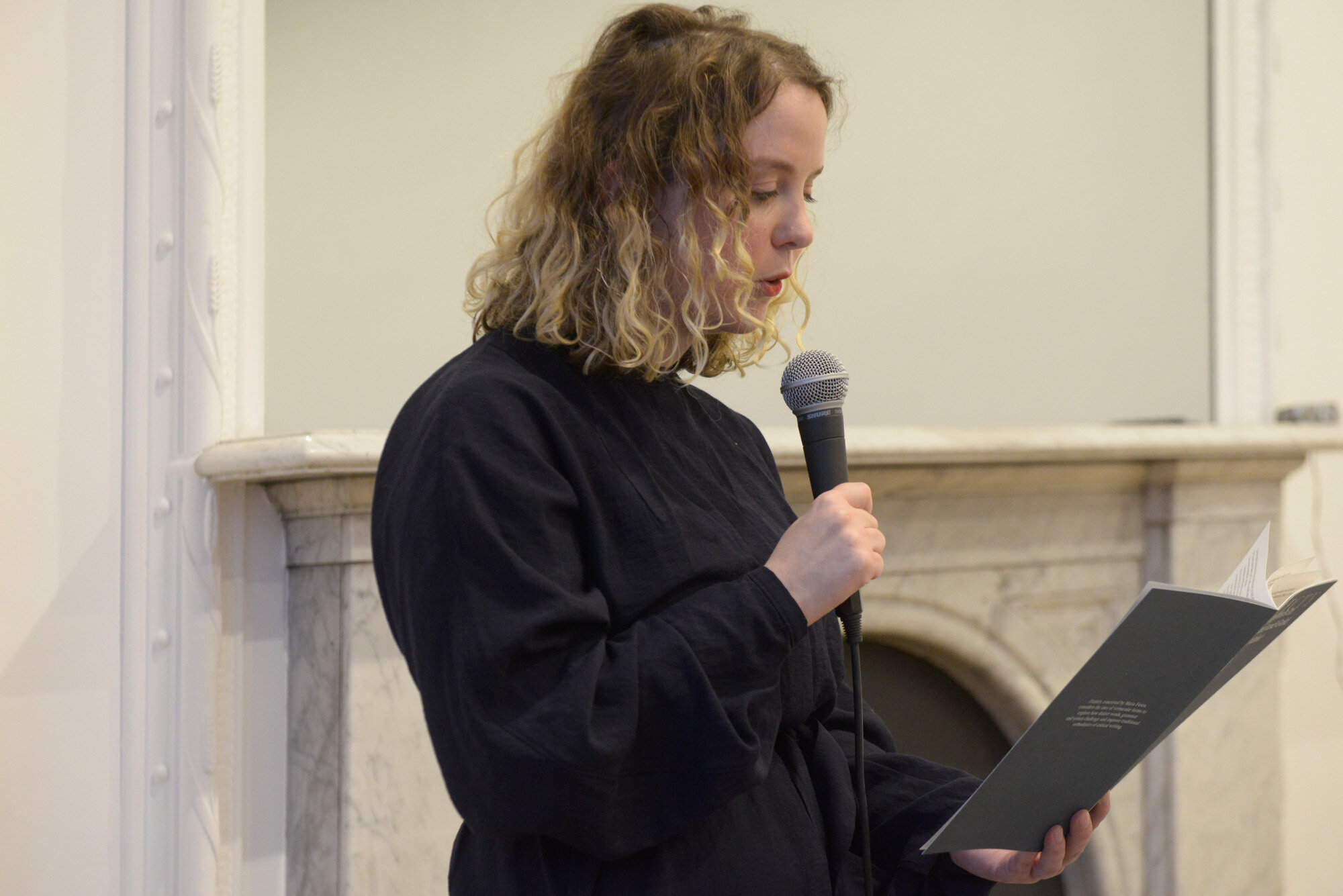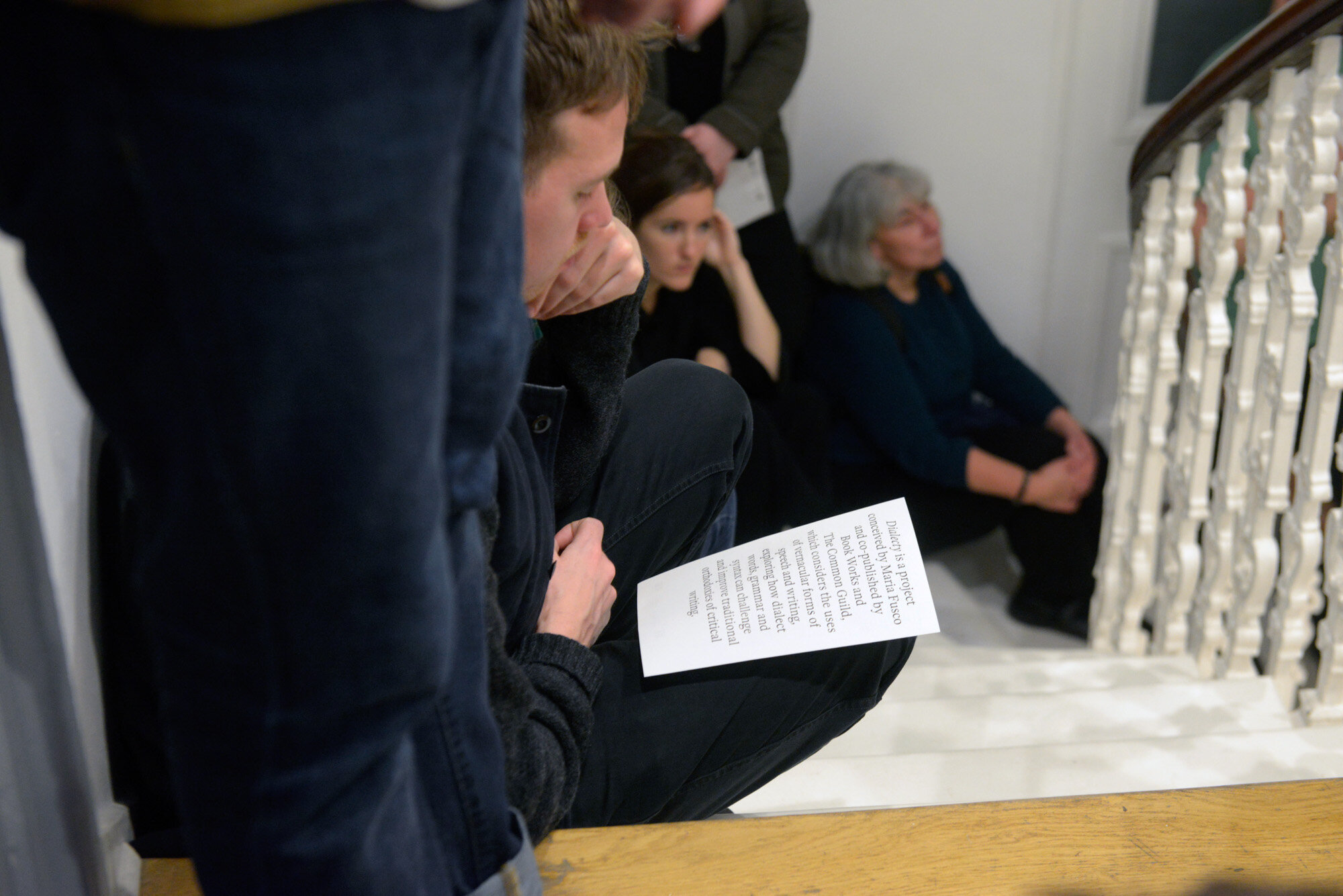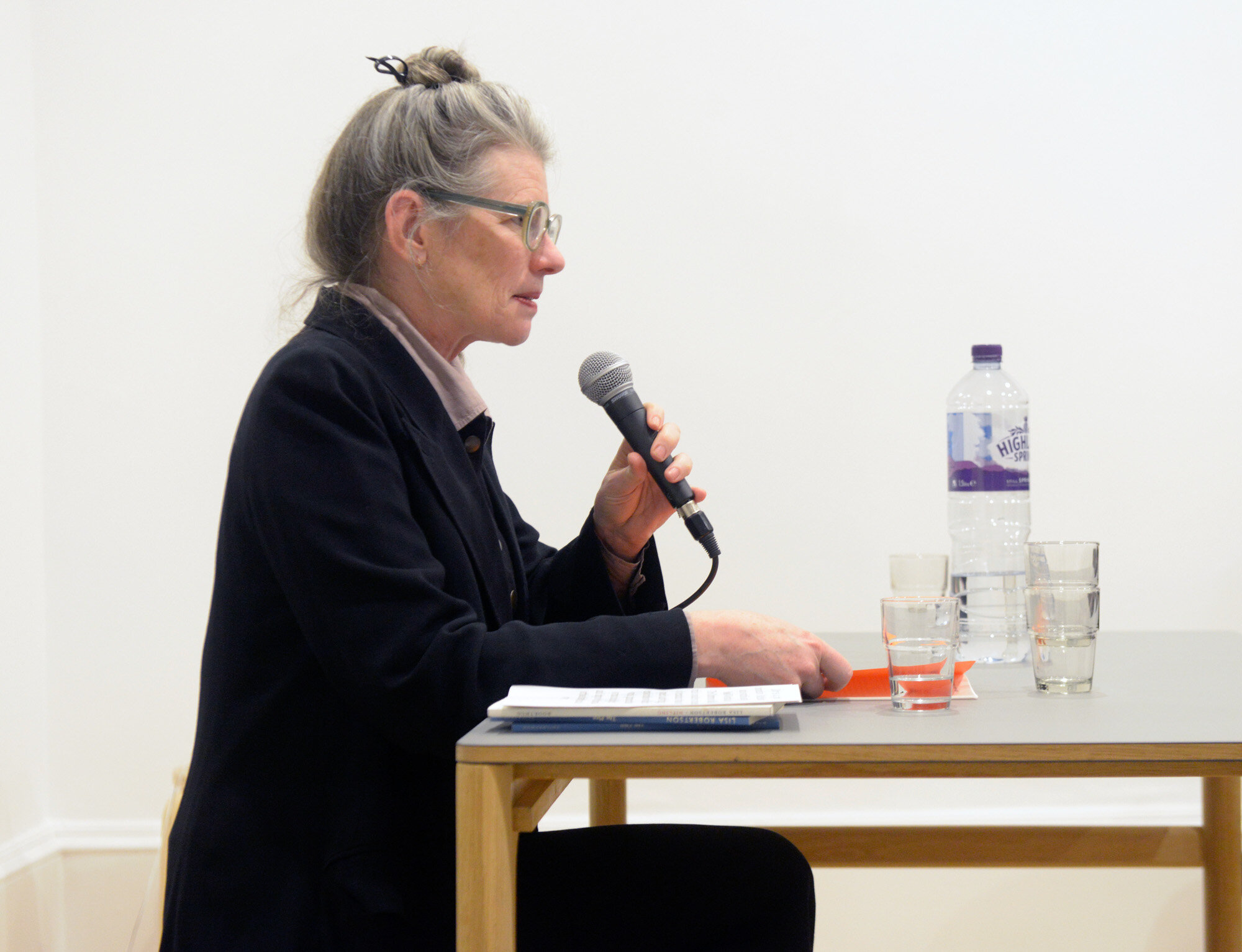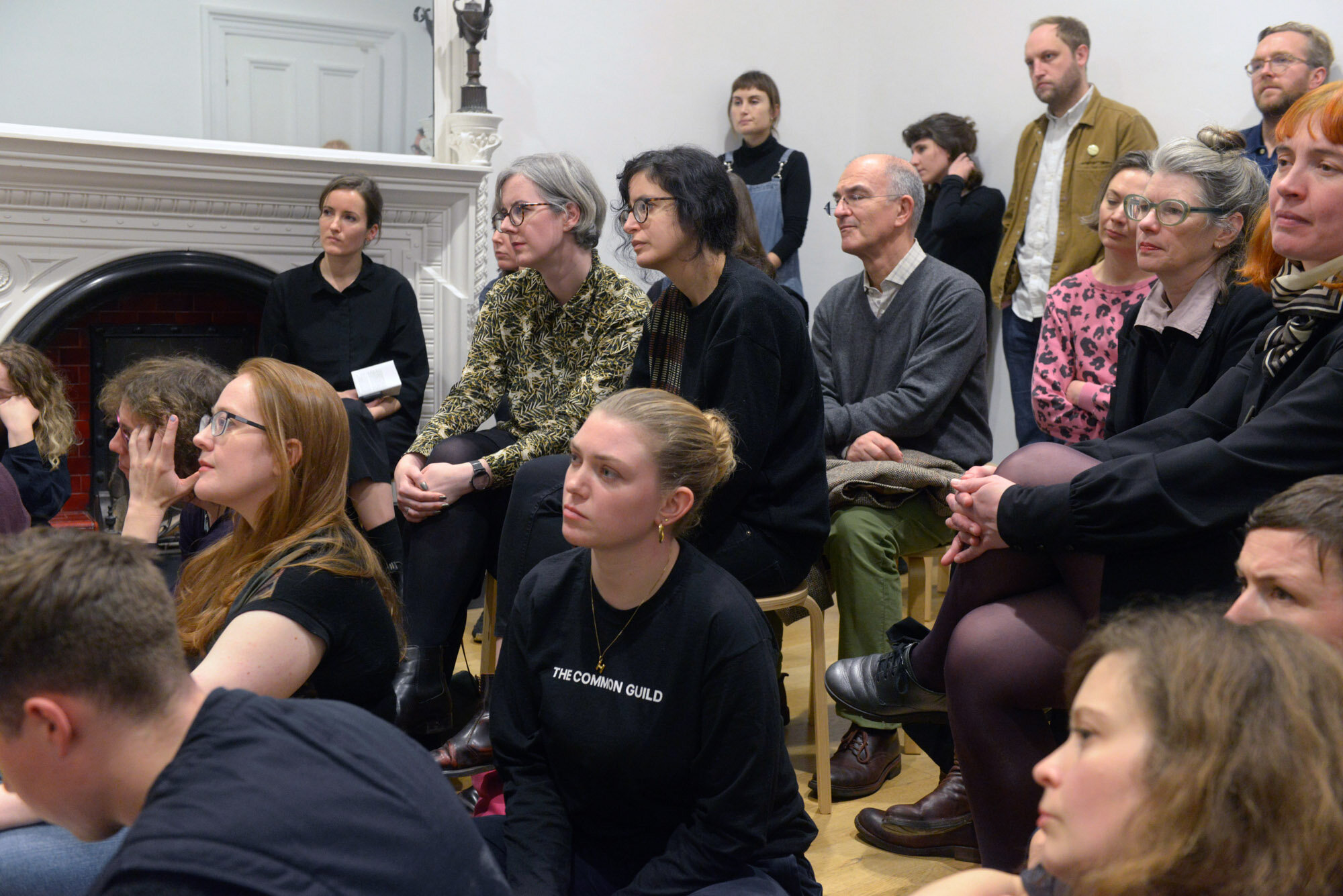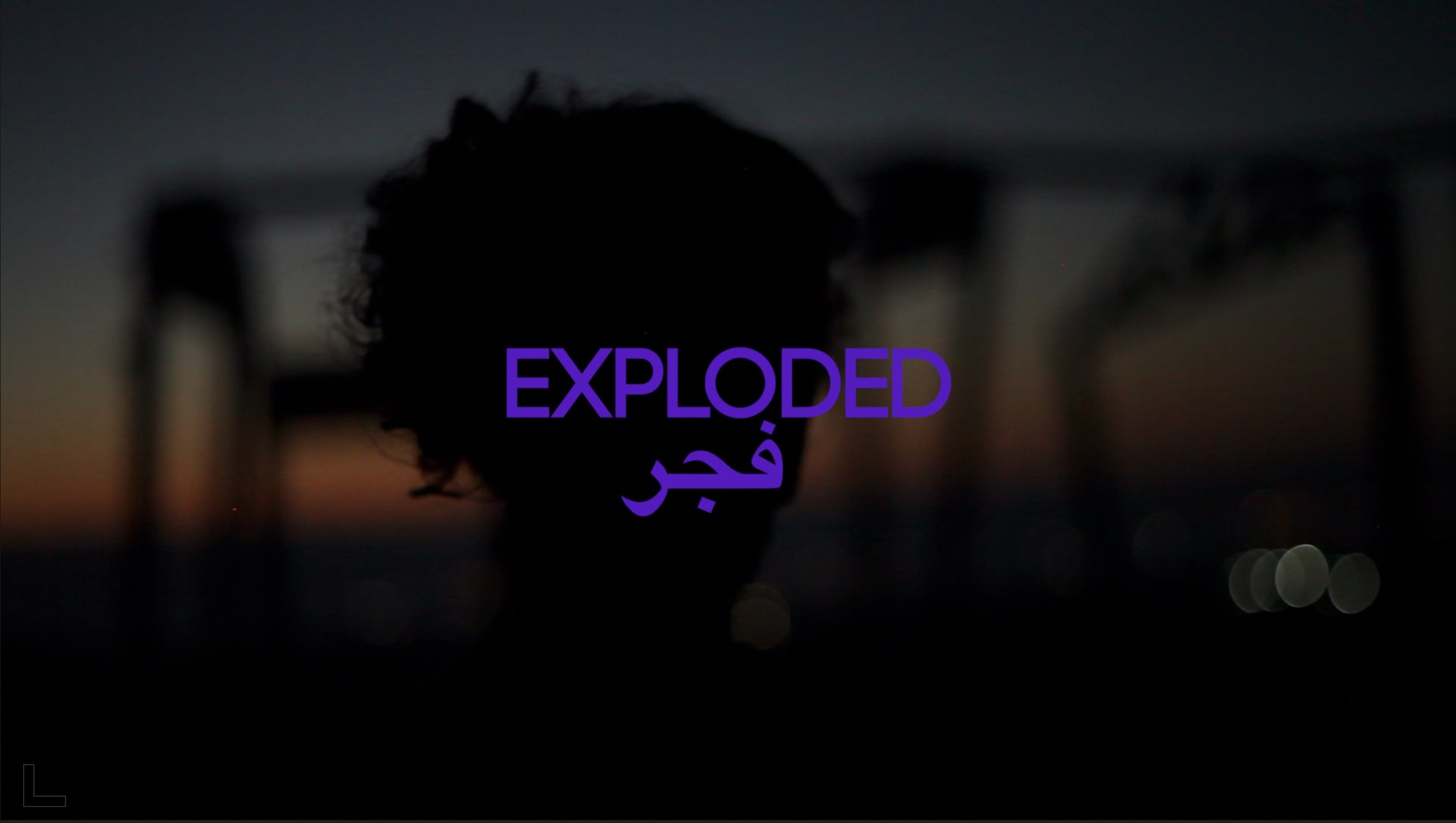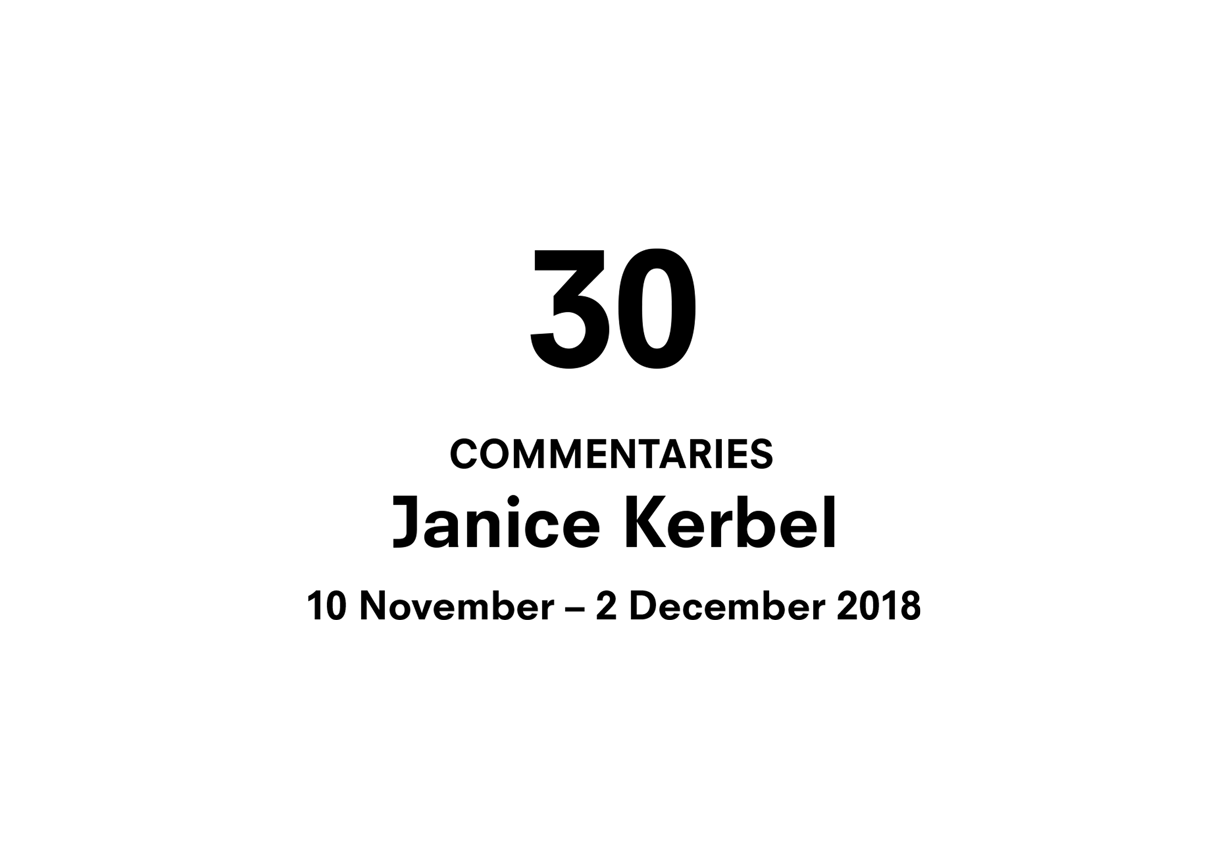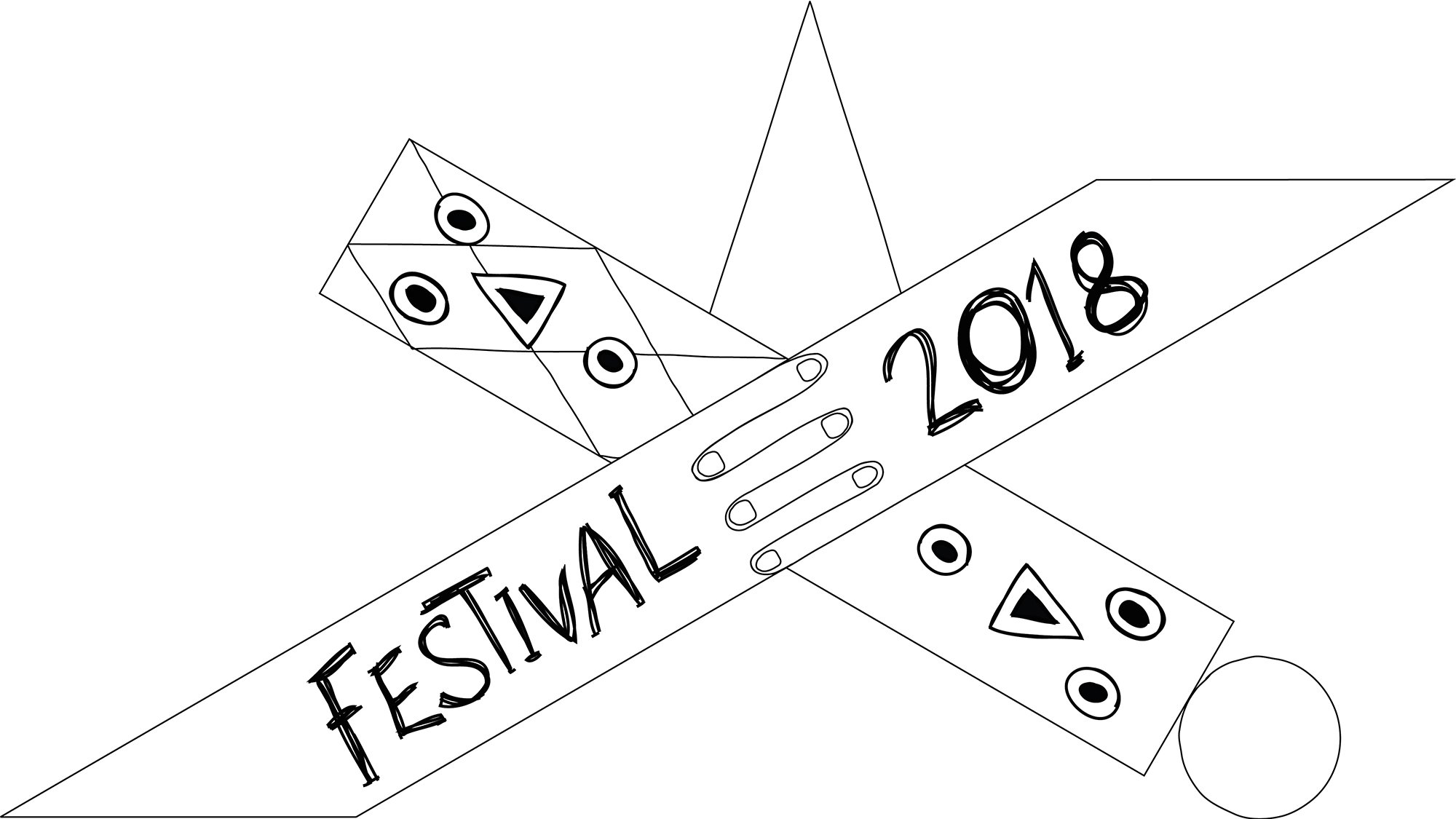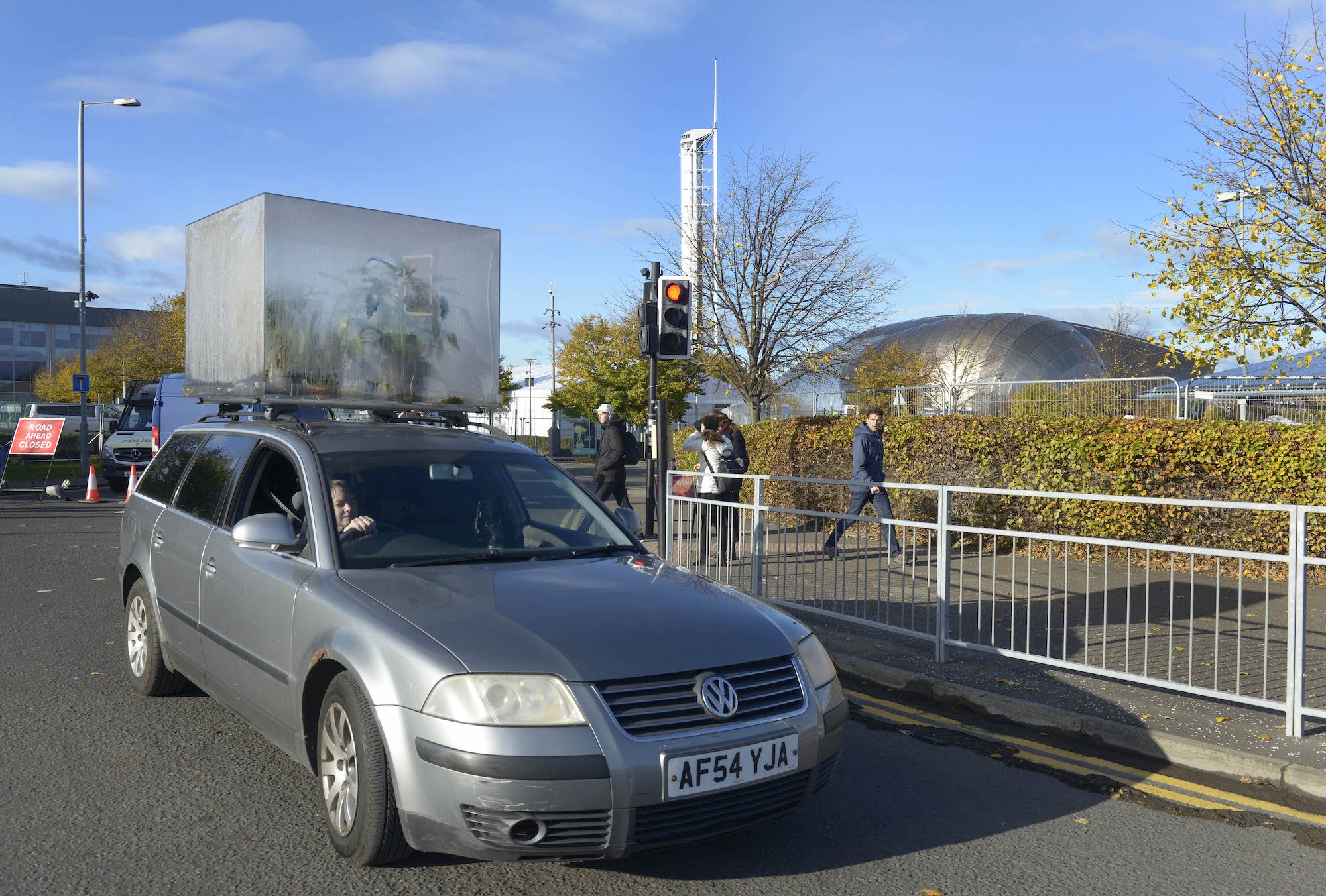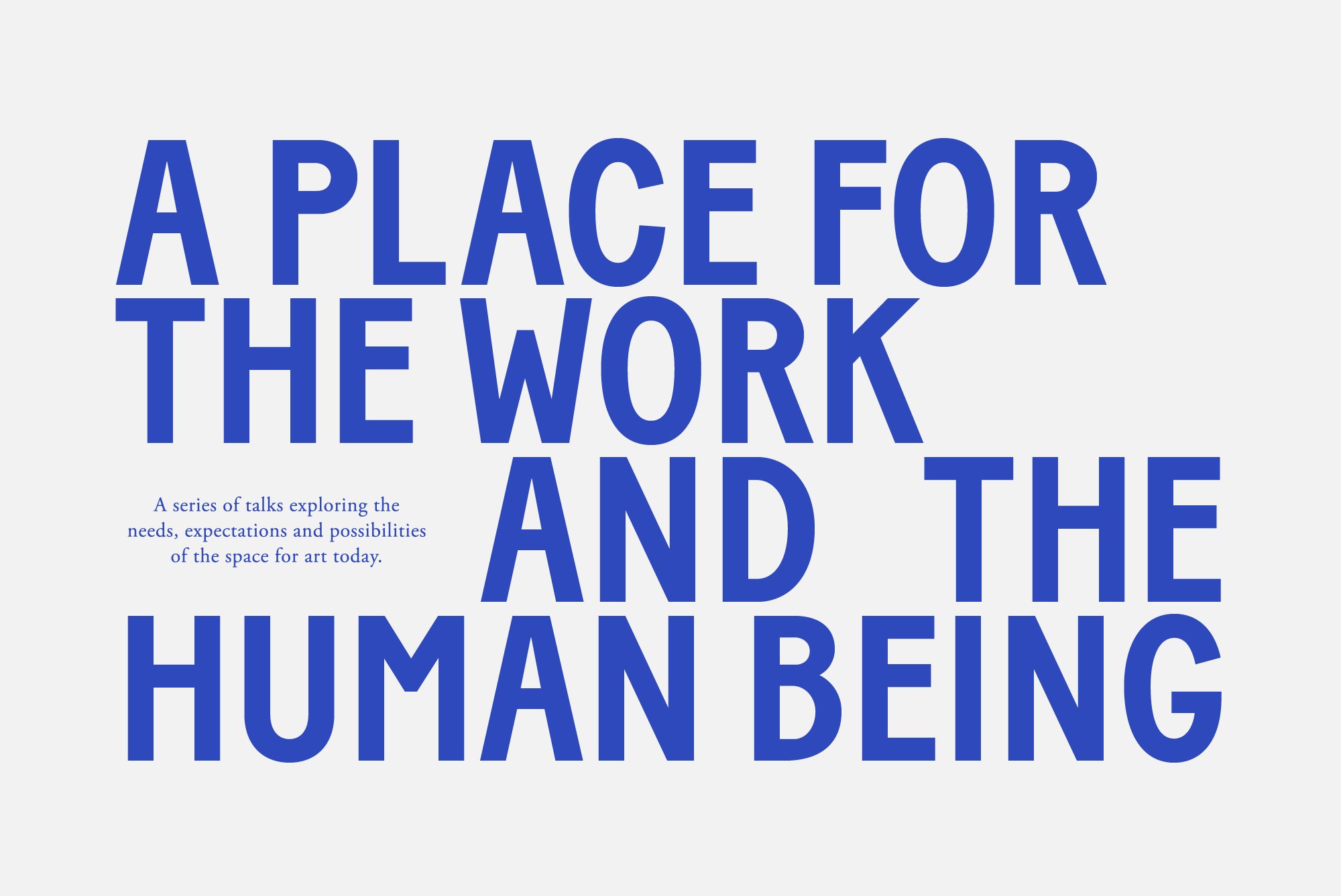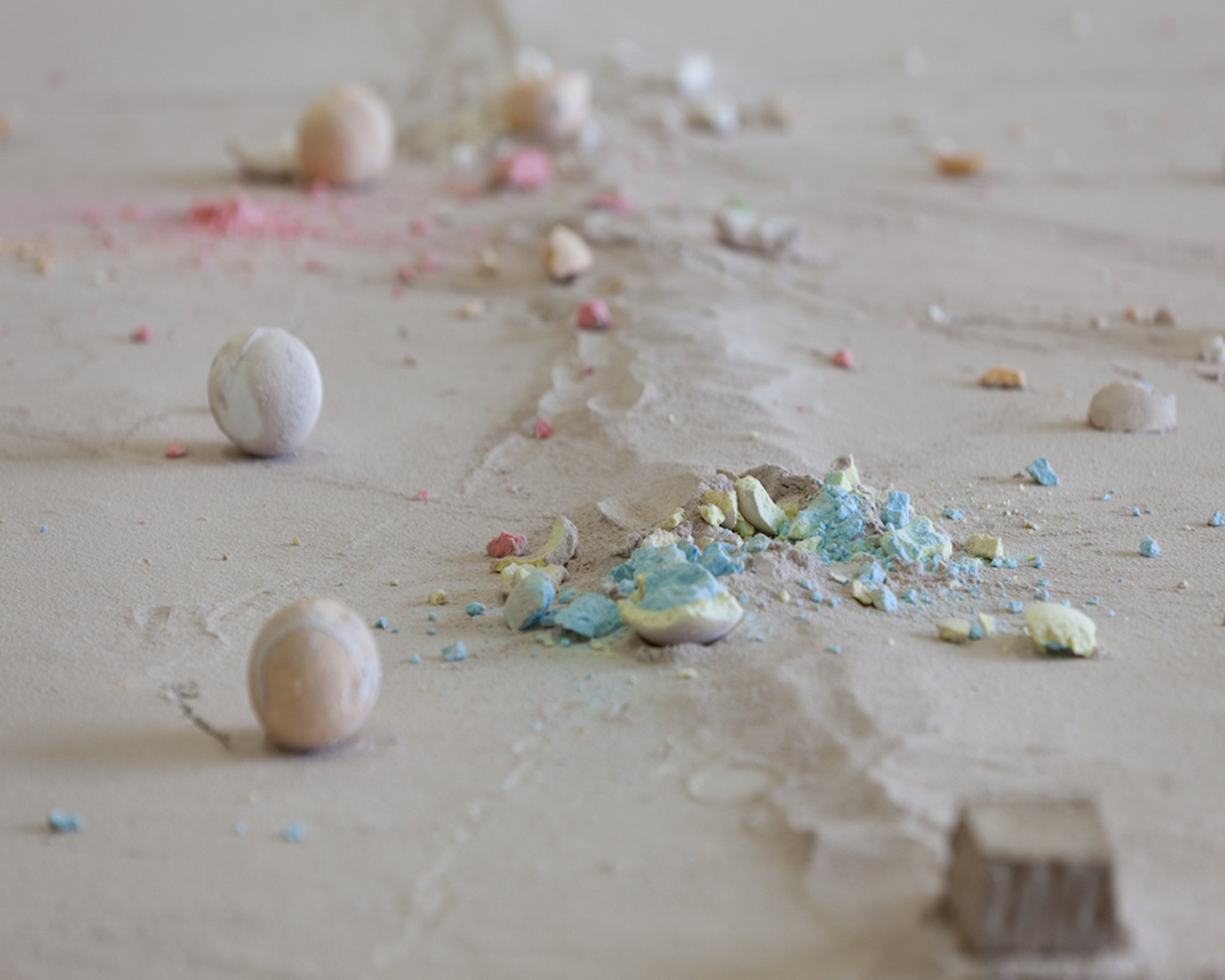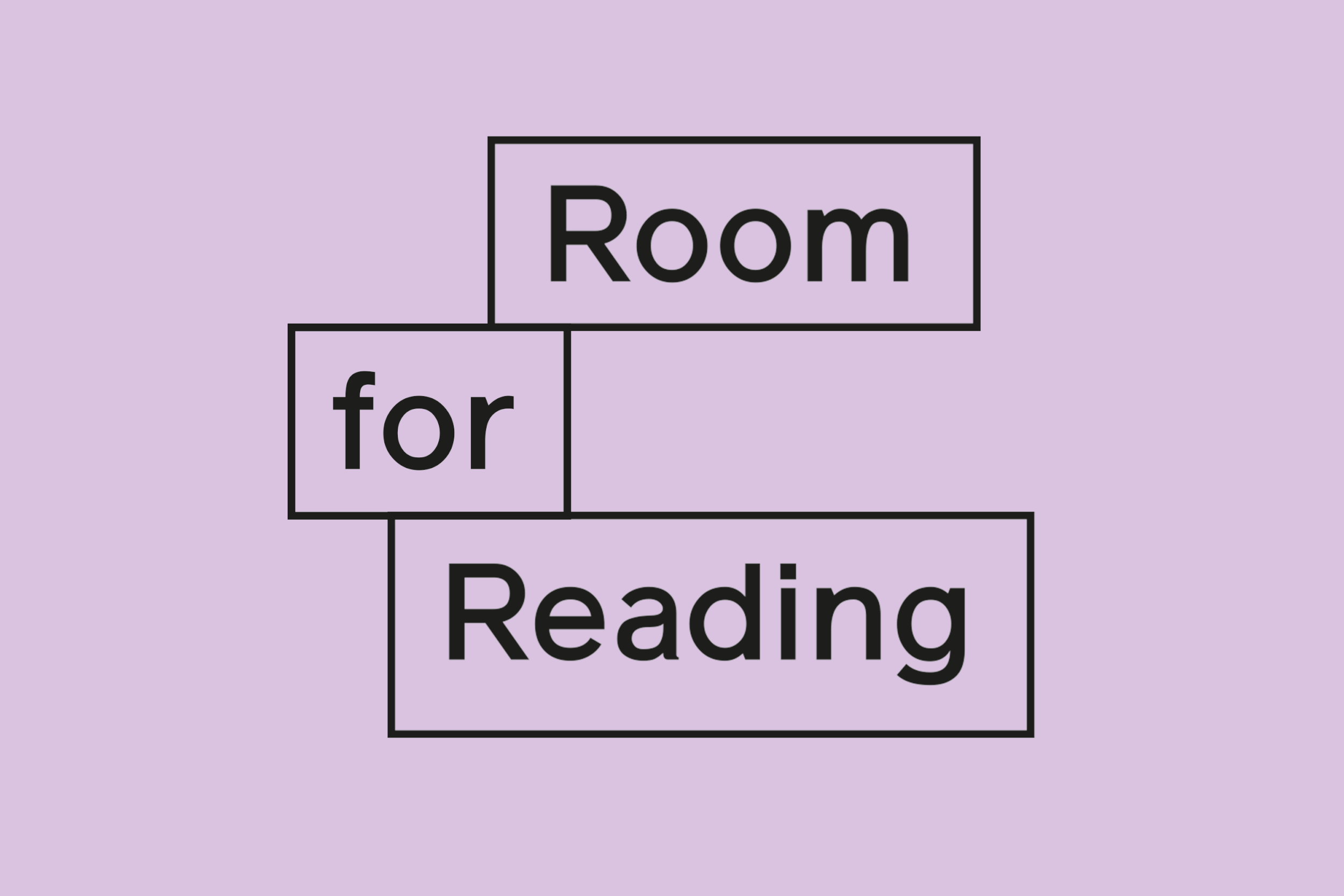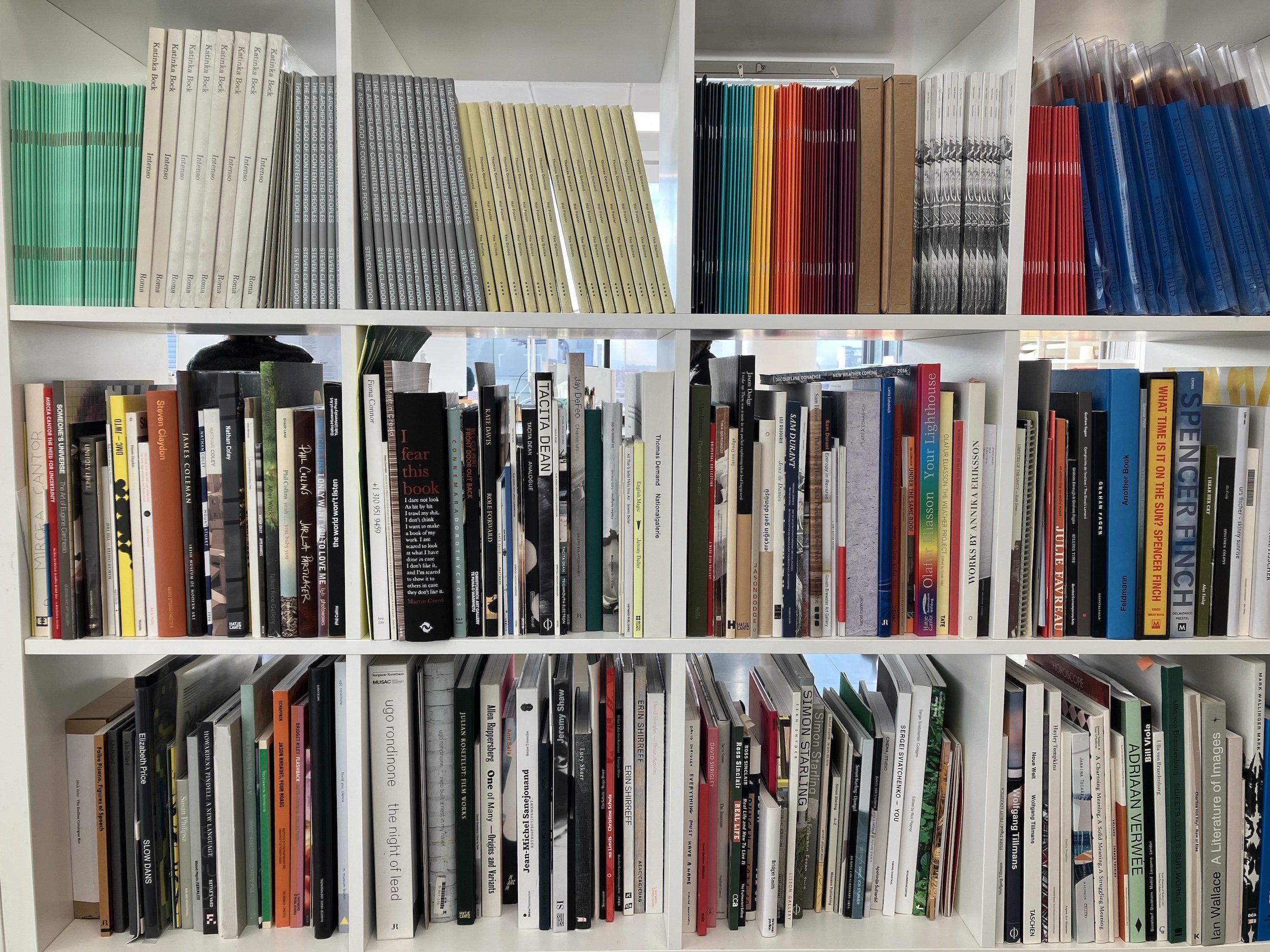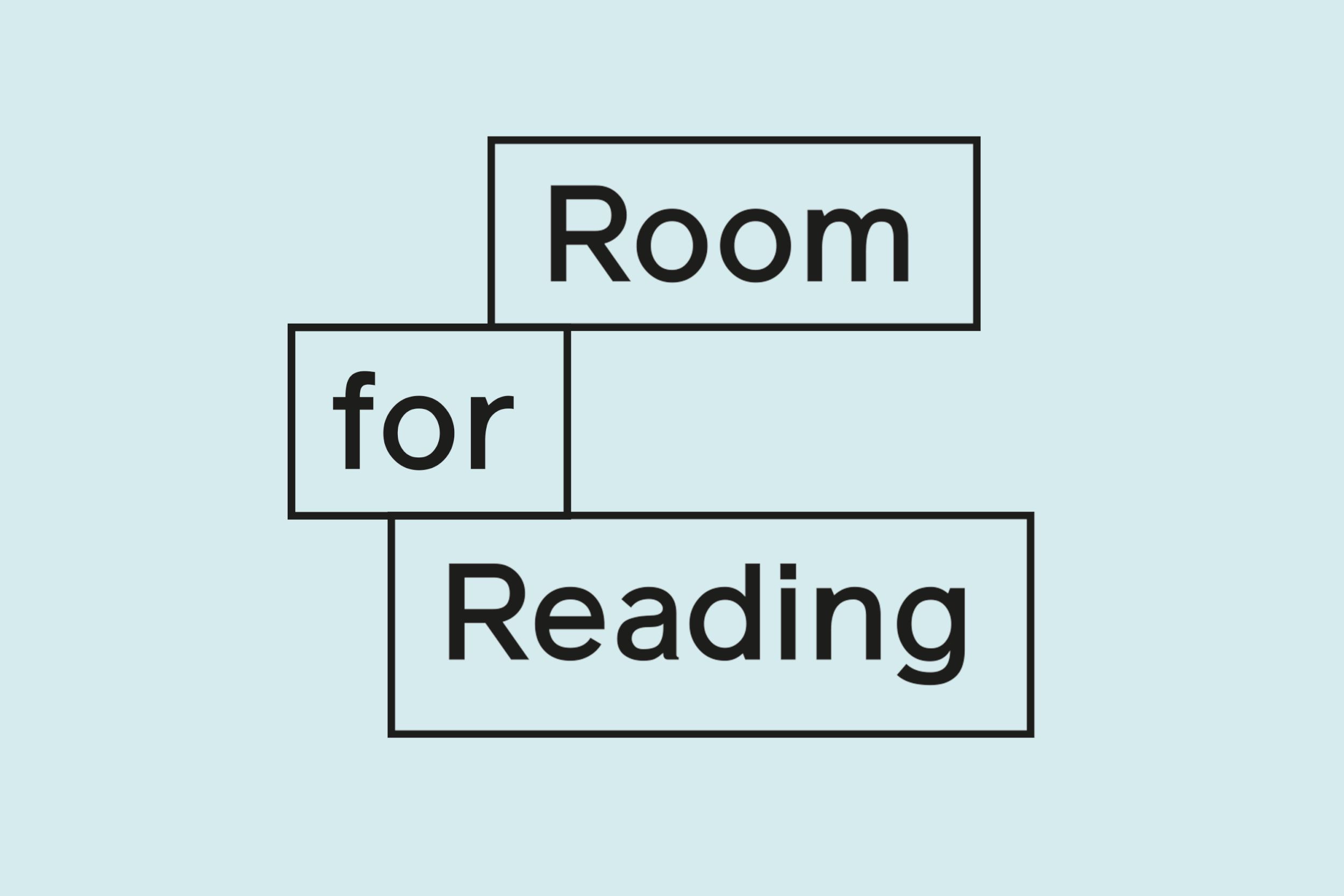
Dialecty – ‘Sometimes Here Has No Walls’
A special launch event for the 'Dialecty' chapbooks series. 'Dialecty', conceived by Maria Fusco and co-published by Book Works and The Common Guild, considers the uses of vernacular forms to explore how dialect words, grammar and syntax challenge and improve traditional orthodoxies of critical writing.
The event included live readings by the contributors: Harry Josephine Giles & Martin O’Leary, Robert Herbert McClean, Helen Nisbet, Lisa Robertson, Adam Pendleton, Natasha Soobramanien & Luke Williams.
Project Details
Listen to selected Dialecty Readings –
Related

Workshop / Movement Scores with G.O.D.S
Janice Kerbel, 'Notes from Sink / Routine for 24 Women' (2018). Photo: Ruth Clark.
Taking Janice Kerbel's synchronised swimming performance 'Sink' as a starting point, this workshop explores the use of "movement scores" as a tool for exploring, learning and sharing dance.
The workshop will take place at The Common Guild, beginning with an introduction to Janice Kerbel's current exhibition 'Notes from Sink: A Routine for 24 Women' followed by a workshop with artists Letitia Pleiades and Ashanti Harris where we will create and respond to movement scores which question and play with how we can physically, collectively and individually be in movement, re-defining our relationship to space, our environment and each other.
G.O.D.S (Glasgow Open Dance School) was founded in 2011 by artists Romany Dear, Letitia Pleiades and Ashanti Harris. G.O.D.S is a not for profit, community organisation, which facilitates free dance and movement-focused activities in different locations in Glasgow.
Related

Exhibition Talk / Minty Donald on Janice Kerbel
Janice Kerbel, ‘Sink’ (2018). Photo: Alan Dimmick.
Minty Donald, Artist and Professor of Contemporary Performance Practice at the University of Glasgow, discusses Janice Kerbel’s synchronised swimming performance ‘Sink' (2018).
Minty considers ‘Sink’ in relation to artists’ documentation of live performance through performance scores and reconstructions.
Event Details
Listen to Minty Donald –
Related

Roundtable Conversation / James N. Hutchinson, Helen Runciman and Letitia Pleiades on Janice Kerbel
Janice Kerbel, ‘Sink’ (2018). Photo: Alan Dimmick.
Roundtable Conversations offer an opportunity to develop various ideas prompted by exhibitions at The Common Guild.
This conversation focuses on Janice Kerbel’s project ‘Sink’ and includes contributions and reflections from the artists James N. Hutchinson and Letitia Pleiades, and independent consultant Helen Runciman.
Event Details
Roundtable Conversations are free to attend and limited to a capacity of ten participants.
Attendees are encouraged to participate in the discussion.
Refreshments and light snacks are available.
Related

Janice Kerbel – Notes from Sink / Routine for 24 Women
Janice Kerbel, 'Notes from Sink / Routine for 24 Women' (2018).
Following the live performance of Janice Kerbel's major new artwork 'Sink’, commissioned by The Common Guild as part of Festival 2018, we are delighted to present an extension of the project with a series of double-sided prints that further explore the language of synchronisation.
Janice Kerbel, 'Notes from Sink / Routine for 24 Women' (2018). Photo: Ruth Clark.
'Sink' is a synchronised swimming routine for 24 women, which was first presented on 3 August 2018 in the distinctive surroundings of the Western Baths, a Victorian swimming pool in Glasgow. Using synchronisation to explore the tensions between body and language, movement and stillness, the individual and the collective, the prints act as a score for and record of a performance. Kerbel treats paper as the surface of water, notating moves and arrangements by hand with use of rubber stamps.
Kerbel regularly works with printed form to invoke real and suggested action. Text-based works such as 'Fight' (2018), a series of silkscreen prints, score an unarmed fight for a group of individuals, while 'Remarkable' (2007), a series of silkscreen prints taking 19th-century fairground posters as its inspiration, heralds the arrival of a series of imagined characters. These printed works both document and instruct action that may or may not have taken place, blurring the distinction between fact and fiction, description and premonition.
Related

Janice Kerbel – 'Sink'
Janice Kerbel’s 'Sink’ is commissioned by The Common Guild as part of Festival 2018, the cultural programme for the Glasgow 2018 European Championships.
‘Sink’ takes the form of a synchronised swimming routine, using the language of synchronisation to explore the tensions between body and language, movement and stillness, the individual and the collective. Synchronised swimming is marked by a unique history infused with the magic of cinema, the discipline of dance, and the precision and athleticism of contemporary competitive sport. ‘Sink’ explores contradictions inherent in the form to imagine a compositional choreography that is both austere and extravagant, performed by specialist, elite female swimmers.
The first live performances of ‘Sink’ took place in the distinctive surroundings of The Western Baths Club, in the west end of Glasgow, on Friday 3 August. Established in 1876, The Western Baths Club is one of a handful of Victorian-era swimming pools in the UK that continue to be in active use. Operated as a private members’ club, ‘Sink’ offers a rare opportunity to visit the building, and to experience the remarkable pool environment through a unique event.
'Sink' is Kerbel’s largest project to date, and builds on her existent relationship with The Common Guild and Glasgow, where her work ‘DOUG’ was commissioned and first presented in the Mitchell Library in 2014. Kerbel was shortlisted for the 2015 Turner Prize for this work, which was re-configured and re-presented in the Turner Prize exhibition at Tramway.
The Western Baths was established in 1876 as a recreational club, mainly but not exclusively, for gentlemen. To this day it continues to provide services for health and wellbeing for all its members and visitors. It is one of a handful of Victorian era swimming pools that continue to be operational, including functioning gym apparatus (travelling rings and trapeze) above the pool, one of only three pools in the UK to retain such features.
Further Info
Documents
Chris Sharratt, ‘Janice Kerbel Dives Into The Surreal Art Of Synchronized Swimming’, Frieze, August 2018
Emma Balkind, ‘Back in at the deep end’, MAP, August 2018
Janice Kerbel, ‘Sink’ reviewed by Adam Benmakhlouf The Skinny, September 2018
Additional Links
The Western Baths Club
Festival 2018
Glasgow 2018 European Championships
Supported by
Project Details
Credits
‘Sink’ was choreographed by Janice Kerbel in collaboration with Adele Carlsen and Lorena Randi.
Thanks
Janice Kerbel would like to thank Borkur Arnarson, Cornelia Grassi, Karin Guenther, Sarah Hale, Catriona Jeffries and Mark Lewis.
The Common Guild would like to thank Aquabatix, Clydebank Synchro, Synchro Caledonia, Synchronised Swimming in Scotland, Malmsten, Katie Nicoll, Scott Paterson, and Lee Ross & the committee and membership of The Western Baths Club.
Related

Roundtable Conversation / Josée Aubin Ouellette, Kate V. Robertson and Frances Robertson on 'Radio Piombino'
Katinka Bock, ‘Radio Piombino’ (2018), installation view, The Common Guild. Photo: Ruth Clarke.
Roundtable Conversations offer an opportunity to develop the ideas prompted by exhibitions and projects at The Common Guild.
Artists Josée Aubin Ouellette and Kate V. Robertson, and academic Frances Robertson lead a discussion focusing on the sculptural work of Katinka Bock and the exhibition ‘Radio Piombino’.
Event Details
Roundtable Conversations are free to attend and limited to a capacity of ten participants.
Attendees are encouraged to participate in the discussion.
Refreshments and light snacks are available.
Related

Exhibition Talk / Moira Jeffrey on Katinka Bock
Katinka Bock, ‘Radio Piombino’ (2018). Installation view, The Common Guild. Photo: Ruth Clark.
Moira Jeffrey responds to Katinka Bock's exhibition, ‘Radio Piombino’.
Moira Jeffrey is a writer based in Glasgow. Her published works include short fiction, criticism and commissioned essays on artists including Alice Neel, Monika Sosnowska and Esther Shalev-Gerz. Most recently she has contributed to new monographs on artists Carol Rhodes and Jacqueline Donachie and the documentary photographer Alan Dimmick.
Event Details
Listen to Moira Jeffrey on Katinka Bock here –
Related

Nasher Prize Dialogues – ‘Artists and Authorship: reference, relationships and appropriation in contemporary sculptural practice’
Photo: Alan Dimmick.
The Nasher Sculpture Center, Dallas, in association with The Common Guild, present a panel discussion with Katrina Brown, Director of The Common Guild, and artists Christine Borland, Sam Durant and Mark Leckey, for the 2018 Nasher Prize Dialogues.
The discussion considers ideas of artistic licence, and the use / re-use of existent material, as well as questions around ownership, originality, responsibility, and ethics in 21st century art production.
The Nasher Prize Dialogues are intended to foster international awareness of sculpture and of the Nasher Prize, and to stimulate discussion and debate.
Inaugurated in 2016, The Nasher Prize is the most significant award in the world dedicated exclusively to contemporary sculpture. It is presented annually to a living artist that has had an extraordinary impact on the understanding of the art form. Previous recipients have been Doris Salcedo, and Pierre Huyghe. The 2018 laureate is Theaster Gates.
Photo: Alan Dimmick.
Christine Borland (Kilcreggan, Argyll) is an artist whose work has often involved collaboration with institutions in other fields, including: forensic science, the history of medicine, medical ethics and human genetics. Borland frequently asks us to consider the fragility of human life and the way in which it is valued by social systems and institutions. Borland was shortlisted for the Turner Prize in 1997. Recent projects have included collaborative work with artist Brody Condon for Edinburgh Art Festival (2012), CCA, Glasgow (2015) and Stroom Den Haag (2016). Borland was the first BALTIC Professor at the BxNU Institute of Contemporary Art, Northumbria University (2011-16). She is currently developing a major research-led commission 'I Say Nothing' for 14-18 NOW and Glasgow Museums at Kelvingrove Art Gallery and Museum (supported by the Art Fund) reflecting on the centenary of the First World War.
Katrina Brown (Glasgow) is founding director of The Common Guild and a former director of Glasgow International Festival (2010 and 2012).
Sam Durant (Los Angeles) is a multimedia artist whose works engage a variety of social, political, and cultural issues. Often referencing American history, his work explores the varying relationships between culture and politics, engaging subjects as diverse as the civil rights movement, southern rock music, and modernism. He has had recent solo presentations in museums LACMA, LA (2014), MACRO, Rome, (2013) and has participated in the Panama, Sydney, Venice, Liverpool and Whitney biennial exhibitions. In 2013, his work ‘Scaffold’ – the subject of controversy in 2017 - was exhibited at Jupiter Artland, outside Edinburgh, after first appearing in documenta 13 in Kassel, 2012. Durant teaches at the California Institute of the Arts in Valencia, California.
Mark Leckey (London) works across multiple media and formats, including sculpture, sound, video, music and performance. Often citing existent artworks or making use of found footage, his notable video works have included 'Fiorucci Made Me Hardcore '(1999) and 'Industrial Light and Magic'(2008), for which he won the 2008 Turner Prize. Leckey’s work has been widely exhibited internationally, including recent solo exhibitions at MoMA PS1, New York (2016) and Wiels, Brussels (2014). His new solo exhibition will be at Tramway as part of Glasgow International from 20th April – 1st July 2018.
The Trades Hall of Glasgow was designed by Robert Adam in 1791-94. The medieval cathedral aside, it is the oldest building in Glasgow still in regular use for its original purpose. It is fully accessible.
Photo: Alan Dimmick.
Event Details
The Nasher Prize Dialogues took place in The Trades Hall of Glasgow and was live streamed by Nasher Sculpture Center as part of Glasgow International 2018.
Related

Katinka Bock – 'Radio Piombino'
Katinka Bock, ‘Dead Cactus’ (2016). Courtesy Galerie Jocelyn Wolff and Galerie Greta Meert.
‘Radio Piombino’ is an exhibition of new, sculptural works by artist Katinka Bock. Bock works with a range of materials, including natural substances, such as copper, lead and clay, and found or given forms. Her materials are often altered through natural processes and the effects of time – heat, moisture or sunlight, for example – such that the potential of becoming or disintegrating seems constantly present. Her sculptures appear as the result of events, at times seeming precarious and at others immutable.
Bock often takes the peculiarities or context of a given space as a starting point for her work, and her project for Glasgow taps into the nature of 21 Woodlands Terrace as a domestic building and the history of Glasgow as a major port, a place of exchange and transaction. Prior to the exhibition several parts of these works inhabited the city of Glasgow and its environs. Copper oxidised; fabric was exposed to the elements; ceramic forms ‘lived’ with city-centre residents and businesses, or were secreted in the woods above Loch Lomond. Bock gathers these elements in their transformed state, looping the references of geological, industrial, meteorological and personal history into her working materials, seeking to reflect the systems that produced the materials, place and people. 'Radio Piombino’ re-imagines 21 Woodlands Terrace as a landscape of sculptural elements that turn the building into what Bock terms a "poisoned body”.
Katinka Bock, 'Radio Piombino' installation view, The Common Guild, 2018. Photo: Ruth Clark.
Katinka Bock is a Paris-based, German artist. ‘Radio Piombino’ is the first presentation of her work in Scotland and follows her only previous project in the UK, ‘Mesonya’, with Siobhan Davies Dance (London) in 2017.
The exhibition is presented as part of Glasgow International 2018 and follows our previous Glasgow International exhibitions with leading international artists including Gabriel Kuri (2014) and Akram Zaatari (2016) and will be accompanied by a series of related talks and events.
Related

Room for Reading / 2018
Room for Reading features publications about and selected by exhibiting artists in our programme.
During 2018 Room for Reading recommendations focus on exhibiting artists Katinka Bock, whose exhibition ‘Radio Piombino’ is presented at 21 Woodlands Terrace from 20 April - 8 July; and Janice Kerbel, whose synchronised swimming project ‘SINK’ takes place at The Western Baths Club on 3 August.
Katinka Bock, ‘Intenso’ (2018); ‘Pazifik’ (2014); and ‘ANY’ (2016).
We have selected three publications on the work of German sculptor Katinka Bock in the run up to the artist’s solo exhibition 'Radio Piombino' at The Common Guild later this year.
Katinka Bock, 'Intenso' (2018), an artist’s book conceived as a prelude to three exhibitions 'Tomorrow’s Sculpture' at Kunst Museum Winterthur, Mudam Luxembourg, and Institut d’art contemporain, (Villeurbanne/Rhône-Alpes); 'Pazifik' (2014) published on the occasion of 'A and I' at the Henry Art Gallery, University of Washington, Seattle; and 'ANY' (2016), an artist book released in conjunction with the exhibition ‘Warum ich mich in eine Nachtigall verwandelt habe’ at Kunstmuseum Luzern, Switzerland.
Watch a short film from the exhibition Katina Bock, ‘Tomorrow’s Sculpture’ at Institut d’art contemporain here.
George Kubler, ‘The Shape of Time’ (1962); Franz Kafka, ‘The Complete Stories’ (1971); Stefan Zweig, ‘Decisive Moments in History’.
For the first of her selections, Katinka Bock recommends 'The Shape of Time: Remarks on the History of Things' (1962) by George Kubler, Franz Kafka’s short story ‘The Cares of a Family Man’ (1914-17) and Stefan Zweig’s 'Decisive Moments in History' (1927).
When it was first released ‘The Shape of Time’ presented a radically new approach to the study of art history, replacing the widely accepted notion of style as the basis for histories of art with the concept of historical sequence and continuous change across time.
Kafka’s ‘The Cares of a Family Man’ or “Die Sorge des Hausvaters” is a puzzling short story of a creature called “Odradek”. The falsely allegorical tale has drawn many interpretations, from Marxist capitalist critique, to a metaphor for the act of writing itself.
First published in English in 1940, 'Decisive Moments in History' is an illustrated history book describing 14 key moments in history, from Napoleon’s defeat at the Battle of Waterloo, to the start of the Russian Revolution.
Read 'The Shape of Time' here.
Read ‘The Cares of a Family Man’ here.
View a photo gallery illustrating Stefan Zweig’s twelve decisive moments here.
‘Documents of Contemporary Art: Materiality’ (2015) edited by Petra Lange-Berndt and Karen Barad, 'Meeting the Universe Halfway' (2007).
Katinka Bock selects two books on materiality: ‘Documents of Contemporary Art: Materiality’ (2015), edited by Petra Lange-Berndt and Karen Barad, 'Meeting the Universe Halfway: Quantum Physics and the Entanglement of Matter and Meaning' (2007) .
‘Materiality’ features writing by Judith Butler and Tim Ingold, and includes artists Jimmie Durham, Zoe Leonard and Kara Walker in an investigation of artistic practice that is concerned with disrupting social norms, and expanding notions of time and space.
The theoretical physicist and feminist Karen Barad elaborates her concept of “agential realism” in 'Meeting the Universe Halfway'. Barad offers an account of the world as a whole rather than as composed of separate natural and social realms, significantly reworking understandings of space, time, matter, causality, agency, subjectivity, and objectivity.
Read a selection of pages from ‘Materiality’ here.
Read 'Meeting the Universe Halfway' here.
Katinka Bock ‘Zarba Lonsa, _0_0__0, Mesonya’ (2018); Katinka Bock ‘The Sound of Distance' (2009); W.G. Sebald 'Vertigo' (2000).
This month Katinka Bock recommends, ‘The Sound of Distance' (2009) from her eponymous site-specific work at De Vleeshal, the Netherlands in 2009, and ‘Zarba Lonsa, _0_0__0, Mesonya’ (2018), a catalogue of three solo-exhibitions by Bock that were linked to 'Zarba Lonsa', a series of sculptures, installation, films and photos instigated during her residency at Les Laboratoires d'Aubervilliers in Paris in 2016.
Bock also selects the novel 'Vertigo' by German author W.G. Sebald (1990; English translation 2000. Described by Stephen Moss as “a curious mix of travelogue, literary essay, philosophical reflection and fictive exploration”, ‘Vertigo’ is W.G Sebald’s first novel and the last to be translated into English. It tells the story of an unnamed narrator, whose journey across Europe invokes ghosts of literary figures of the past, drawing the reader, line by line, into a dizzying web of history, biography, legends, and memory.
Watch W.G. Sebald speak about his work here.
Janice Kerbel, ‘Deadstar’ (2006); Charles Sprawson 'Haunts of the Black Masseur: The Swimmer as Hero' (1992); Janice Kerbel ‘LIVE’ (2018).
In the first of Janice Kerbel’s Room for Reading recommendations, the Canadian artist selects her own publications 'Deadstar' (2006) and ‘LIVE’ (2018) along with Charles Sprawson’s 'Haunts of the Black Masseur: The Swimmer as Hero' (1992).
‘Deadstar’ is a limited edition publication that accompanied ‘Deadstar: Ghosttown’ a copperplate photogravure etching by the artist. The etching takes the form of a town plan to envisage a timeless settlement for ghosts, and the publication includes essays by Mark Godfrey and Susan Morgan, and an extract from Lyall Watson’s ‘Supernature’.
Kerbel’s 'LIVE' brings together three scripts and one score written over ten years. Performative works assembled in this book are ‘Nick Silver Can’t Sleep’, a radio play for insomniacs in the voices of six nocturnal plants; ‘Kill the Workers!’, a play for stage lights inspired by dramatic narrative; ‘Doug’, a live vocal performance of nine songs for six voices; and ‘Ballgame’, a radio announcement of a baseball game conceived by mathematical averages.
Charles Sprawson, himself an obsessional swimmer, explores the meaning that different cultures have attached to water in 'Haunts of the Black Masseur’. From Classical Greece to Virginia Woolf, Sprawson offers anecdotes of great swimming heroes.
Read more about ‘Deadstar’ here.
Listen to ‘Nick Silver Can’t Sleep’ featured in ‘LIVE’ here.
Watch a film adaptation of 'Haunts of the Black Masseur’ here.
Thomas van Leeuwen 'The Springboard in the Pond: An Intimate History of the Swimming Pool' (1998); Synthia Sydnor 'A History of Synchronised Swimming' (2014).
This month Janice Kerbel has selected 'A History of Synchronised Swimming' (2014) by Synthia Sydnor and 'The Springboard in the Pond: An Intimate History of the Swimming Pool' Thomas A. P. van Leeuwen (1998).
Sydnor’s 2014 article for the journal Body Politics is a meditation on the form and essence of synchronized swimming. van Leeuwen’s 'The Springboard in the Pond’ investigates the swimming pool as a quintessentially modern and American space, reflecting America's infatuation with hygiene, skin and recreation. This text looks at the domestic swimming pool and discovers an icon through which to read 20th-century modernism.
Read 'A History of Synchronised Swimming' here.
Watch a lecture by Thomas van Leeuwen on The Springboard in the Pond here.
Details
Room for Reading is a space to engage with research related to our programme as recommended by the artists and collaborators we work with at The Common Guild.
Books are suggested in conjunction with our projects, exhibitions and events.
Artists’ selections are added to The Common Guild’s expansive reference library of artist books, catalogues, and cultural and critical theory.
The Room for Reading at 21 Woodlands Terrace was open on the first Thursday of every month. Designed by artist Andrew Miller the reference library was open from lunchtime until late, with tea and coffee provided.
Related

Maria Fusco – 'Dialecty'
Student preparing Revel decorations, 1950, painting the mouth of a paper mache dinosaur head. © Edinburgh College of Art.
"I am for adjectives like beezer, dreich, quare, and nouns like clart, drouth, gleed, mizzle, oxters, scoot-hole, smoor, and verbs like boke, fissle, greet, hunker, swither, and adverbs like furnenst."
Maria Fusco
'Dialecty' has been conceived by writer Maria Fusco to consider the critical uses of vernacular forms of speaking and writing. The project explores the occurrences and potential uses of dialect words, syntax and language within the field of contemporary art and questions traditional orthodoxies of creative and critical writing within contemporary art.
Fusco writes “I am for non-standard English language as a legitimate and enriching form of critical and creative writing which does not take modalities of criticality as given, rather it tends to, and experiments with non-division between practice and theory, criticism and creativity."
In 2017 a cycle of events with Lisa Robertson, Dr Lauren Hall-Lew and Scott Hames will be presented at The Common Guild. A series of chapbooks with writing by Harry Josephine Giles & Martin O’Leary, Robert McClean, Helen Nisbet, Lisa Robertson, Adam Pendleton and Natasha Soobramanien & Luke Williams will be launched in 2018.
Maria Fusco is an award-winning Belfast born writer based in Glasgow, working across fiction, criticism and theory, her work is translated into ten languages. Her latest work are the performance ECZEMA! (National Theatre Wales, 2018) is described in Frieze as "an extraordinary text", and the books Legend of the Necessary Dreamer (London: Vanguard Editions, 2017) as “a new classic of female philosophical fiction” by Chris Kraus and Give Up Art: Collected Critical Writings (LA/Vancouver: New Documents, 2017) of which James Elkins had written "Maria Fusco is one of the most inventive and informed practitioners of art writing... After a book like this, most nonfiction seems curiously unaware of what writing can be." Master Rock is a repertoire for a mountain, commissioned by Artangel and BBC Radio 4, the experimental radio play has been experienced by more than 2.5 million listeners. She is a Professor at Northumbria University, previously a Reader in Interdisciplinary Writing at University of Edinburgh and Director of Art Writing at Goldsmiths, University of London.
Further Info
Additional Links
The ‘Dialecty’ chapbooks series is available from Bookworks.
‘Dialecty’ is funded by the University of Edinburgh and the Elephant Trust.
Supported by
Project Details
‘Dialecty’ chapbooks are co-published by Book Works and The Common Guild, as part of Co-series.
